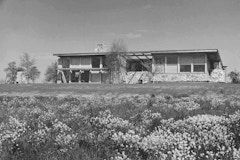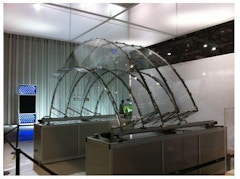
165 results
-
 Cost-effective, sustainable, self-actuating, thermally-responsive, bio-composite exo-skins that act like shields or cloaks for existing buildings…
Cost-effective, sustainable, self-actuating, thermally-responsive, bio-composite exo-skins that act like shields or cloaks for existing buildings… -

When Facades Kill
- Paper by Terri Meyer Boake,
The tragic fire of June 14, 2017 at the Grenfell Tower in London, England has brought to a very public global forum issues related to the impact of… -

Orientation Specific Solar Control
- Paper by Clifton Fordham
During the postwar era, and before the universal adoption of air-conditioning in the United States, leading architects participated in the design of
-
Let Thin Glass in the Facade Move
- Paper by Prof. DI Dr. Jürgen Neugebauer · DI Dr. Markus Wallner-Novak
Facades play an important role in the control of energy flow and energy consumption in buildings as they represent the interface between the outdoor
-

Nested Density
- Paper by Wendy Cox, Architect
Projecting imagery onto building facades is not only becoming a marketing necessity for successful urban spectacles but is also altering social urban
-

Facade Games
- Paper by James Tice, Professor of Architecture
This paper provides an overview of a course focusing on the façade as taught to architecture students over a twenty-year period. The need for this… -

Terra Cotta Skins
- Paper by Laura B. Garofalo
This paper will address the potential of ornamental architectural terracotta surfaces to mitigate the effects of climate fluctuations that will
-
Insulating Glass Unit Gas Loss
- Paper by Mark K. Schmidt, M.Eng., S.E. · Stephen M. Morse, PhD, P.E.
Concerns over time-dependent argon permeation through the perimeter edge seals of insulating glass units (IGUs) led the authors to utilize two
-

Retroreflective Coating for Window Blinds
- Paper by Luca Papaiz · Lars Oliver Grobe · Giuseppe De Michele
Solar shading devices are required to find a trade-off between conflicting requirements: Protection from excessive solar gains and glare, daylight
-

Kinetics in Building Facades
- Paper by Sean Cullen, Professor Greg Keeffe,
The prominence of climatically responsive building facades through the use of kinetics has proliferated in recent years due to a concern for the… -
Growing Myceliated Facades
- Paper by Thibaut Houette, M. Arch. · Brian Foresi · Christopher Maurer, AIA, NCARB · Dr. Petra Gruber
Today's sustainability in architecture takes into consideration the complete life cycle of buildings and their components, from resource harvesting
-

Architectural Shape Optimization
- Paper by Patricia Edith Camporeale, PhD, Posdoc researcher
This paper explores the architectural shape optimization of typical housing typologies: slab and high-rise residential buildings to reduce primary… -

Design Considerations
- Paper by Stephen M. Morse, Ph.D. · Kayla Natividad, Ph.D. · H. Scott Norville, P.E., Ph.D.
Window glass design using ASTM E 1300 entails determining glass thickness(es) and types so that the window glass construction load resistance
-

Historical Evolution of Responsive Facades
- Paper by Negar Heidari Matin, Ph.D. Candidate, LEED GA · Ali Eydgahi, Ph.D. · Shimming Shyu, Ph.D., RA, LEED AP BD+C · Payam H. Matin, Ph.D.
Responsive facade system is considered a major component of high-performance building envelope that is capable of responding to environmental stimuli
-
Consistency In Glass Design
- Paper by Joshua Schultz, PhD, PE, LEED AP · Grace Dojan
Glass structural elements have become increasingly common to the point of ubiquity; however, there currently is no universally recognized and
-

The Double Skin Facade
- Paper by Lee A. Fithian, AIA, AICP, NCARB, LEED AP,
The largest source of air pollution in North America is the atmospheric boundary layer of a city caused by its urban canyons with pollutants produced… -
Facades Education in the United States
- Paper by Ajla Aksamija, PhD · Suncica Milosevic · Gabrielle Brainard · Timothy Brown
This paper presents the results of a research study, outlining the state of facades education at higher-education institutions across the United
-

Design Principles For Museum Daylight Systems
- Paper by Edgar Stach, PhD · Michael Esposito
This research unlocks the relationship between space, structure and light in nine unique museums developed by architect Renzo Piano. Renzo Piano uses
-

Put Your Sweater On!
- Paper by Eric Haas, AIA, LEED AP BD+C, Adjunct Associate Professor
During the particularly cold first months of 1977 President Jimmy Carter, in what some call “The Sweater Speech,” famously noted how much energy… -

Ceramic Precast Composite Panels
- Paper by Edward Rubio, Edward J. Rubio, Gregory Lucier, Ph.D., Brian Moskow, PE, Sami H. Rizkalla, Ph.D., FACI, FASCE, FEIC, FCSCE, FIIFC, FPCI,
An innovative lightweight ceramic precast composite panel is introduced in this paper that offers the unique benefits of prefabricated off-site…

